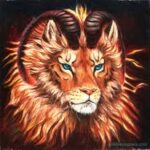I want to take a moment and talk about La Sirena by John Picacio.
La Sirena is an illustration for Picacio’s upcoming Loteria project, it won the 2013 Chesley award for product illustration, and it’s one of the images from his 2014 calendar. You can see it if you go to his kickstarter page and scroll down.
Go on. I’ll wait. Open it in a new window so you can have it up next to this blog as you read.
To understand the context of how I relate to art, particularly art containing topless women, one must understand that I have been increasingly sensitized to the portrayal of women’s bodies in art—especially naked ones. Having an actual woman’s body by with which to compare these illustrated ones, I am acutely aware that they are often romanticized ideals rather than accurate representations, and a lot of the time those ideals are not the ones I personally hold. Furthermore, the depiction of women in the context of fantasy illustration is rife with campy poses and overt sexualization which is at best comical and at worst blood-rage inducing. My favorite (read: least favorite) is the classic “tits+ass spinebreaker” which is most commonly found in comic books but has appeared elsewhere. In it, the woman is put into a impossible contortion so that she is displaying both her bosom and her derrière to the viewer. (Try doing that in the mirror, guys. Just try it.) The point is clearly to display as much of the woman’s assets as possible, with no regard to her internal anatomy or the believability of the pose, and a certain amount of confusion about whether she’s a character or a blow-up toy.
Given this, one can begin to understand why La Sirena is such a welcome change. In it, we see a topless woman, but she is posed conservatively and—and this is the kicker—realistically. It is as though she just happened to be doing this and the artist caught her at a moment when, from his point of view, her right upper arm just happened to drift between his line of sight and her boobs. So it doesn’t look like one of those contrived “Oops! We can’t show nipples here, move a finger!” pictures—which is itself a major accomplishment. The pose is also notable in that she appears to be doing something; her arms aren’t just floating there artistically. The artist has given them purpose and tension and strength—in such a way that they just happen to look dramatic and artistic. I cannot stress enough how much this encapsulates the very heart of what illustration is, and how very difficult it is to pull off.
Then let us consider her attractiveness. She is beautiful, yes, but in a haunting, slightly scary way. She’s clearly not human, and the diving helmet suggests that, should you become enchanted by her song, you would not meet a happy fate. This is not just a piece of eye candy (although she is very enjoyable to look at), this is a force that, while pleasant enough to behold when safely trapped on a piece of paper, is not something you’d want to meet in real life. In this way she transcends any objectification the viewer might bring to the picture, and becomes a character in her own right.
Now I would like to take a closer look at her features. I like that she is well rounded—not too thin. Moreover, I like that she has been given features that are not overtly Caucasian. Considering that she is an illustration for a thematically Mexican card game it would be easy to assume that she is of Central American ethnicity, but because—due to the surrealistic style of the colors—we cannot really know what color her skin is, she could be any number of races. She has that soft, round nose and full lower lip that evokes African, Asian, and Native American ancestry—all depending on what preconceived notions the viewer brings to the piece. That is a very large cross-section of the population, especially when you take into account that a lot of self-identified “white” people are actually a mix of different races and often exhibit characteristics we usually associate with brown-skinned people. Take into consideration also the fact that the white-washing of characters in science fiction and fantasy illustration has been (and continues at times to be) a major problem, and it is particularly gratifying to find an instance of an artist coming as close as possible to depicting a “neutral” race person. That is, a person whose race is dependent entirely upon the viewer. I am part Japanese, and so I see the Japanese characteristics about her. But I imagine, if I was Indian, I’d see her as Indian. And so on. And considering that she is a fantastical being this attribute is especially fitting, because it allows people of many different ethnicities (or, as in my case, a mix of ethnicities) to see themselves in her. I feel this is important when one is dealing with made-up characters, because allowing the viewer to see a bit of themselves in your creation will help to ground them, and creates a connection between the creation and the viewer that will make it seem more real. And when your creation is a rainbow-skinned octopus lady you need all the realness you can get.
Finally, as a minor note, I’d just like to add: the scales on those fishes are amazing. Mad details there, bro.
Basically John Picacio is the best and you should go back his Kickstarter. And if you can, back it enough to get one of the calendars—I have his 2013 calendar, and I am here to say these things are awesome.
*
Goldeen Ogawa is a writer, illustrator and cartoonist. Aside from John Picacio, her other favorite artists include James Gurney and Ursula Vernon. You can email her at goldeenogawa@gmail.com or peck at her on Twitter @GrimbyTweets.


























